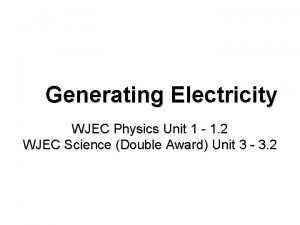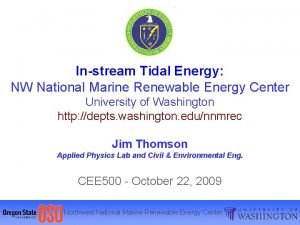Alternative energy Tidal powerstations What is a Tide














- Slides: 14

Alternative energy Tidal power-stations

What is a Tide ? • Tides are the rising and falling of Earth's ocean surface caused by the tidal forces of the Moon and the Sun acting on the oceans.

What is the Tidal force ? • The tidal force is the vectorial difference between the gravitational force of the Earth and the gravitational force of the Moon.

About tidal power • Tidal power, sometimes • called tidal energy, is a form of hydropower that exploits the movement of water caused by tidal currents or the rise and fall in sea levels due to the tides. Although not yet widely used, tidal power has potential for future electricity generation and is more predictable than wind energy and solar power.

History of Tidal power stations • An early attempt to build a • tidal power plant took place at Aber-Wrac'h in the Finistere in 1925, but due to financial problems, it was abandoned in 1930. Tidal mills have long existed in areas affected by tides. In Europe, tide mills have been used for over a thousand years, mainly for grinding grains.

Principle of tidal power stations • 1. Barrages make use of the potential energy from the difference in height (or head) between high and low tides. Barrages suffer from the problems of very high civil infrastructure costs, few viable sites globally and environmental issues.

• 2. Tidal stream systems make use of the kintetic energy from the moving water currents to power turbines, in a similar way to wind mills use moving air. This method is gaining in popularity because of the lower cost and lower ecological impact.

Examples of tidal power stations • La Rance: The first and largest tidal plant in operation is the 240 MW plant built for commercial production across the La Rance estuary in north-western France between 1961 and 1967. The tidal power plant has 24 bulb-type Kaplan turbines with a rated capacity of 10 MW each.

• Annapolis: The second commercially operated tidal power plant built in 1984 in the Western hemisphere is a 18 MW plant at Annapolis Royal on the Nova Scotia coast of the Bay of Fundy in Canada.

• Other sites: Other plants include the 400 k. W experimental unit at Kislaya Guna, built in 1968 in Russia on the Barents Sea, and the 3. 4 MW Jianxia station built in China between 1980 and 1986. Most of the technically available tidal resources in Europe are in the UK. The site in the Severn estuary in southwestern England represents a potential of 8 GW and has been the object of several feasibility studies. Large potential also exists in northern France, at the Cotentin Peninsula in Normandy.

Advantages of using tidal power: • Predictable source of “green" energy during lifetime of • • barrage It produces no greenhouse gases or other waste; it needs no fuel. Not expensive to maintain. Tidal energy has an efficiency of 80% in converting the potential energy of the water into electricity Vertical-axis tidal generators may be joined together in series to create a ‘tidal fence’ capable of generating electricity on a scale comparable to the largest existing fossil fuelbased, hydroelectric and nuclear energy generation facilities

Disadvantages of using tidal power: • A barrage across an estuary is very expensive to • • • build, and affects a very wide area - the environment is changed for many miles upstream and downstream it provides power for around 10 hours each day, when the tide is actually moving in or out, which is not very much Existing ecosystems would be heavily altered, with new species moving in and perhaps dominating old species Tidal power schemes have a high capital cost

Global enviromental impact • A tidal power scheme is a long-term source of • electricity. A proposal for the Severn Barrage, if built, has been projected to save 18 million tonnes of coal per year of operation. This decreases the output of greenhouse gases into the atmosphere. If fossil fuel resource is likely to decline during the 21 st century, as predicted by Hubbert peak theory, tidal power is one of the alternative source of energy that will need to be developed to satisfy the human demand for energy.

 Spring tide and neap tide
Spring tide and neap tide Neap and spring tides
Neap and spring tides The tide rises the tide falls meaning
The tide rises the tide falls meaning The tide rises, the tide falls
The tide rises, the tide falls Neap tide spring tide
Neap tide spring tide Neap tide spring tide
Neap tide spring tide Pros of tidal energy
Pros of tidal energy Tidal energy ltd
Tidal energy ltd Environmental impact of tidal energy
Environmental impact of tidal energy Tidal energy pros and cons
Tidal energy pros and cons Tidal energy assignment
Tidal energy assignment Tidal energy pdf
Tidal energy pdf Tidal energy
Tidal energy Cominstream
Cominstream Tidal power animation
Tidal power animation

























